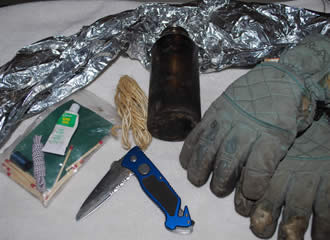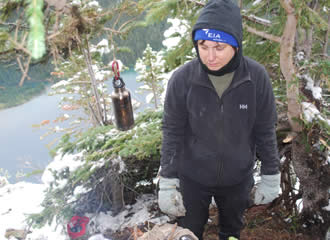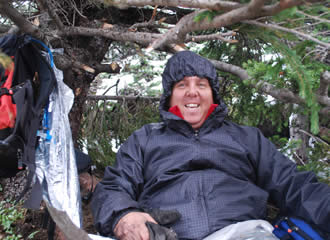"There was no way for us to get down from where we were and no way to go up - we were trapped."
My name is Trina Jackson. I took your survival weekend course with the SARDAA group a couple of years ago. This September long weekend my husband, David, and I went for a day hike in Waterton Lakes National Park. We started our hike at 10:00 A.M. had hiked in about 10.5 Km and done approximately 1280 meters (4200 foot) of elevation gain. The weather had been a bit sketchy in that we had sun, sprinkles of rain, and even the odd snowflake, and then it would go back to sun again. As we made it past the scramble and up on top of Akamina Ridge, an unexpected snowstorm blew in when we had just reached the top of the ridge (2620m/8600ft). This was about 1:30 PM. We thought at the time that it was would be like the rest of the sketchy weather and would blow over. We continued to make our way along Akamina Ridge. However, as the snow started to come down harder and faster, it began to accumulate on the ground and the landscape looked different. We determined that we would not be able to complete the hike and needed to return back. However, with the quickly accumulated snow on the ground, and the near zero visibility, we lost the trail and could not find the trail exit down off the ridge. By this time, we were extremely exposed to the elements and knew we were in trouble.

We had to get out of the storm, which meant our only option was to get off the Ridge. We managed to work our way off the ridge, but we were nowhere near the trail. We were able to find some shelter in small caverns in the rocks, but there was no means for fuel for a fire, and the blizzard was still coming down hard and fast. We started to head towards trees. This took us on a path of scrambling down cliff sides and small waterfalls, much of it done by sliding down on our backsides. Twice David grabbed me and saved me from tumbling off the mountain.
We finally managed to make it toward a very small group of pine trees. This took us approximately four hours. We were still high up and it was close to dark – we had less than two hours before dark to get something set up. By now six inches of snow had fallen. Nothing looked the same. We thought we had made it to the area of Cameron Lake where we knew there was an interpretative centre, tea shop and canoe rental and were hopeful that someone would hear our cries for help. We were wrong. The area we had made it to was Wall Lake. Wall Lake is a more remote area and only has the occasional cyclist or day hiker.
It was below zero with the added danger of gusting winds and we were soaking wet. Things were looking pretty bad. Because of taking the survival course through Boreal Wilderness Institute, I always carry a number of items. Between my husband David and myself we had strike anywhere matches, flint, knife, emergency blanket, metal water bottle, string, tea bags, cheese, jerk, trail mix, hot pockets, a large vinyl poncho, toques, winter gloves and strangely but most importantly a small tube of tent sealer.
We were on a cliff face that was at about a sixty-degree angle and so there was no means to built a proper shelter. However, we were able to get a few small pine trees cut down with the knife we were carrying and some pine bows. We used those to make as much of a shelter as we could to protect us from the elements under the largest spruce tree. Using a rock sticking out of the ledge David stacked more small rocks around it so we could have a place to light a fire. I tried lighting a fire using a small twig bundle and a bit of tissue I had. I had foolishly taken out my fire starter the night before to start a fire where we were camping and had not put it back in my pack. After many tries we were not able to get the fire started.
"Not only was it highly flammable, it also did not extinguish quickly. It did the trick and at last we had fire."

We used the base of the spruce tree as an anchor and were able to wrap ourselves together around the tree base to keep from rolling down the mountain and tried to conserve our body heat and rest. Keeping in mind we were soaking wet, we knew no one would be looking for us yet and we were there for at least the night. We had to get a fire started or we were at risk of dying of hypothermia. David went back to try again to light a fire. He made a couple of attempts with the strike anywhere matches and still no fire. At that point we remembered the small tube of tent sealer we had. It's a thick sticky substance, which in this case turned out to be highly flammable. Not only was it highly flammable, it also did not extinguish quickly. It did the trick and at last we had fire.
My role was to keep the fire going and David, using the knife and brute strength, gathered up what wood he could. Every time he ventured for wood was a terrifying experience as it was now dark and he could with one small misstep tumble off the mountain. Sometimes he came back with a few sticks that were two inches in diameter other times all he could get were pencil thick twigs - no matter what he found, it was soaking wet and hard to burn. With patience and skill we managed to keep the fire going all night. At first we had to have the fire a bit bigger and even managed to dry our clothing except for our feet. After that we kept it very small, just enough to keep us from freezing and to keep the embers going.
David would go out to get wood, then warm by the fire and he would have to scramble up by the tree base, wrap himself up in the emergency blanket and vinyl poncho and rest. We used the metal water bottle and string to hold the bottle over the fire to melt the snow for drinking water. I stuffed an herbal tea bag in the bottle and we had warm liquids to drink and help keep us warm.
We made it through the night and at daybreak we started hollering for help once again at regular intervals. We were dangerously low on firewood with no means of finding more and with daylight we knew we had to do more to make our shelter better in case we were there for another night. I knew one of our issues was no rest and the other was we had no ability to lie close to the fire. David used some larger flat rocks to make something of a bench above the fire. We could not lie down, but we could sit together. I started laying smaller flat rocks around the fire in the hopes that if we ran out of firewood we could lay them flat with a few pine boughs over them and they might radiate some heat to keep us from freezing to death for a bit longer. Sitting on the bench with my feet above the fire provided me with some relief for my extremely cold wet feet, but by no means managed to dry them. We could still feel the water squishing between our toes when we stood by the fire. We also still had the hot pockets in reserve, but were saving those for when we ran out of firewood.

We always register with the park wardens when we go out on overnight hikes, but we did not register with them for our day hike. No one would be looking for us yet. I had my cellphone with me, but there was no cell service. Our only hope was that someone would hear our cries for help. However, this was Waterton and the Monday of the September long weekend. Waterton pretty much shuts down after the long weekend and we knew most visitors would be heading home. Add on the fact that there had been a snowstorm the previous day, many hikers and cyclists would be discouraged from venturing out. There was no way for us to get down from where we were and no way to go up - we were trapped. If we had to spend another night there we probably live, but we would be in extremely rough shape by morning. Where we were, if we died there no one would have ever found our bodies and we knew that. Things were looking very desperate.
Luck was with us around 11:30 am when a cyclist heard our cries for help. He had to peddle back down to the Waterton park rangers to report us. He told us he would get help. The elation we felt can never be adequately described. Eventually a ranger hollered up to us and said a helicopter had been called in. It took several hours for it to arrive, as it had to come from Cranbrook. Once it came it still took them an hour to actually locate us. They then had to leave again to go get the correct gear required to rescue us…that took an hour and forty-five minutes. When they came back, two rescue workers were dropped down. They had screamer suits, helmets and goggles for David and I and we were each air lifted off the cliff, flown over Wall Lake and put on the ground. Before getting me off the cliff they gave me a heat pack to help keep me warm as no amount of movement could stop my teeth chattering and body shaking by this point in time.
In total it still took five and a half hours from when our cries were first heard to when we were taken off the mountain. All in all we spent 31 hours out in the elements. I share all this with you because much of what you taught during your course helped give us the tools and knowledge to survive our ordeal. If anyone is a hiker, hunter or spends any time outdoors I would say your course is mandatory. Thank you.
"If anyone is a hiker, hunter or spends any time outdoors I would say your course is mandatory."
Additional Resources
- Trina's Group took the Survival Core Seminar and the Summer Field Session
- Search and Rescue Resources

